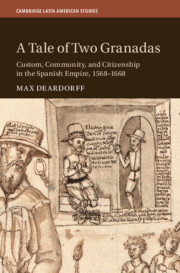Book contents
- A Tale of Two Granadas
- Cambridge Latin American Studies
- A Tale of Two Granadas
- Copyright page
- Contents
- Figures
- Maps
- Tables
- Acknowledgments
- Introduction
- 1 Iberian Antecedents
- 2 Politics, Reform, and the Emergence of Christian Citizenship
- 3 Moriscos, Arabic Old Christians, and Spanish Jurisprudence (1492–1614)
- 4 Cultivating the Christian Republic: The New Kingdom of Granada and the Archbishop Zapata de Cárdenas
- 5 Life in the City: The Casa Poblada and Urban Citizenship
- 6 The Roots of the Mestizo Controversy in the New Kingdom of Granada
- 7 The Mestizo Priesthood
- 8 Mestizo Officials in the Christian Republic
- 9 Urban Indians in Santafé and Tunja, 1568–1668
- Epilogue
- Glossary
- Bibliography
- Index
- Other Books in the Series (continued from page ii)
2 - Politics, Reform, and the Emergence of Christian Citizenship
Published online by Cambridge University Press: 27 July 2023
- A Tale of Two Granadas
- Cambridge Latin American Studies
- A Tale of Two Granadas
- Copyright page
- Contents
- Figures
- Maps
- Tables
- Acknowledgments
- Introduction
- 1 Iberian Antecedents
- 2 Politics, Reform, and the Emergence of Christian Citizenship
- 3 Moriscos, Arabic Old Christians, and Spanish Jurisprudence (1492–1614)
- 4 Cultivating the Christian Republic: The New Kingdom of Granada and the Archbishop Zapata de Cárdenas
- 5 Life in the City: The Casa Poblada and Urban Citizenship
- 6 The Roots of the Mestizo Controversy in the New Kingdom of Granada
- 7 The Mestizo Priesthood
- 8 Mestizo Officials in the Christian Republic
- 9 Urban Indians in Santafé and Tunja, 1568–1668
- Epilogue
- Glossary
- Bibliography
- Index
- Other Books in the Series (continued from page ii)
Summary
Chapter two examines how the foundations of Christian citizenship began to take shape in regional conciliar movements in Spain, coming into maturity with the Crown’s ratification of the Council of Trent in 1564. As the Christian republic of the Spanish Empire became more diverse, the Crown put its weight behind a legal revolution that would provide the Church with a more coherent set of policies. The Catholic Church conceived the Council of Trent (1545-63) as an answer to the Protestant Reformation and a device with which to effect a reform of the administration of the Church.The Spanish monarchy welcomed the Council’s reforms enthusiastically. However, the Spanish incarnation of Tridentine (adj., from Trent) reform was unique, in that it functioned as an instrument of political consolidation that provided the monarchy the tools necessary to create some semblance of uniformity within a growing empire.
Keywords
- Type
- Chapter
- Information
- A Tale of Two GranadasCustom, Community, and Citizenship in the Spanish Empire, 1568–1668, pp. 52 - 77Publisher: Cambridge University PressPrint publication year: 2023

